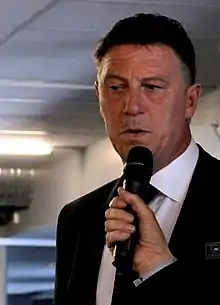 | ||||
| Full name | Djurgårdens IF Fotbollsförening | |||
|---|---|---|---|---|
| Nickname(s) | Järnkaminerna ("The Iron stoves") Blåränderna ("The Blue stripes") | |||
| Short name | DIF | |||
| Founded | 12 March 1891 1899 (football section) | |||
| Ground | Tele2 Arena, Stockholm | |||
| Capacity | 30,000 | |||
| Chairman | Lars-Erik Sjöberg | |||
| Head coach(es) | Kim Bergstrand & Thomas Lagerlöf | |||
| League | Allsvenskan | |||
| 2023 | Allsvenskan, 4th of 16 | |||
| Website | Club website | |||
|
| ||||
Djurgårdens IF Fotbollsförening – commonly known as Djurgårdens IF, Djurgården Fotboll (official name), Djurgården (IPA: [ˈjʉ̂ːrˌɡoːɖɛn]), and (especially locally) Djurgår'n (IPA: [ˈjʉ̌ː(r)ɡɔɳ]), Dif or DIF[upper-alpha 1] – is the professional men's association football department of its parent association Djurgårdens IF. Founded 1891 on the island of Djurgården, the club's home ground is Tele2 Arena, situated in the Johanneshov district of Stockholm.
Competing in the highest Swedish tier, Allsvenskan, the club has won the league twelve times and the cup five times. The league titles have mainly been won during three separate eras. The first period was the 1910s, when the team won four league titles. The second era occurred in the 1950s and 1960s, when Djurgården won the league four times. The most recent era was during the first half of the 2000s, when they won both the league and the cup three times. From 2017 to the current day, the club has seen a boom, both nationally and internationally, highlighted by the Svenska Cupen title in 2018, the league title in 2019, and their qualification to 2022–23 Europa Conference League round of 16.
Supporters of the club, called djurgårdare, are found in all socio-economic spheres and throughout all areas of Stockholm and, to some extent, all over Sweden. However, East Vasastan and Östermalm, the latter in particular where Djurgården's former home ground Stadion is situated, is by some considered the club's heartland. Djurgården is affiliated to the Stockholms Fotbollförbund.[1]
History
Foundation
Djurgårdens IF was founded primarily by John G. Jansson, on 12 March 1891, at a café in Alberget 4A in the island Djurgården in central Stockholm. Most of the founding members were from the dockyard-industry working class,[2] an identity that stayed true up until the 1940s and 1950s.
The club originally focused on winter sports and athletics. The first true football field in Stockholm was created in 1896. Djurgårdens IF's football department was formed in 1899 with the help of former GAIS player Teodor Andersson.[3] Djurgården played their first match in July 1899, a 1–2 loss against AIK.[3]
First four Swedish Championship titles (1910s and 1920s)

The team's first real achievement was made in 1902 when the team finished second in the Rosenska Pokalen tournament. Just two years later, in 1904, the club participated in its first Svenska Mästerskapet final, ending in a defeat against Örgryte IS.[4]
The team lost three more Swedish Championship finals, all against teams from Gothenburg, (1906 against Örgryte, 1909 against Örgryte and 1910 against IFK Göteborg) before the first victory came in the 1912 final, with a 3–1 win against Örgryte.[4] In 1910, the first Djurgården players were selected for the national team, Ivar Friberg, Erik Lavass, Samuel Lindqvist, and Bertil Nordenskjöld played a friendly against Norway on 11 September 1910.[5]
The club won three more Swedish Championships in the 1910s and 1920s, the 1915 final against Örgryte, the 1917 final against AIK, and the 1920 final against IK Sleipner, and played a total of twelve finals in the 30 editions that was played of the championship until 1925.[4] Bertil Nordenskjöld and Ragnar Wicksell were part of the champion squad all four finals, and Gottfrid Johansson, Einar Olsson and Sten Söderberg in three of them.[6] Nordenskjöld played in all Djurgården's Svenska Mästerskapet finals.[7] Although the team became Swedish champions four times during the period of a cup championship, Djurgården never managed to win the national league of the period, the Svenska Serien.
Djurgården did not qualify for the first season of Allsvenskan, and only reached that league twice between 1924 and 1944, in 1927–28 and 1936–37, both times being directly relegated back down to the second tier Division 2. The club also played three seasons in the then third highest league, Division 3 (Swedish football), between 1929 and 1932. From 1944 on, Djurgården became a stable Allsvenskan team.
Stockholm Olympic Stadium, built for the 1912 Summer Olympics, became Djurgården's permanent home ground in 1936, replacing Tranebergs IP.
1950s and 1960s champions era

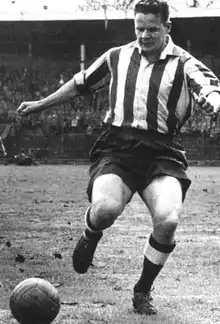
The second great era took place in the 1950s and 1960s, with Djurgården winning Allsvenskan four times during the period.
In 1951, the team became runners-up in Svenska Cupen after a 1–2 final loss against Malmö FF; this was the team's first Svenska Cupen final.[8]
Djurgården's fifth Swedish championships, and first Allsvenskan win, was taken in the 1954–55 season under the lead of Frank Soo. In the 1955–56 season, Djurgården became the first Swedish team to enter the European Cup.[3] Beating Gwardia Warszawa in the first round, Djurgården advanced to quarter-finals against Scottish Hibernian that they lost by 1–4 over two matches.[3]
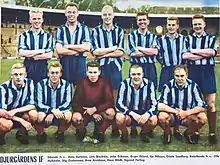
In 1959, both the football team and Djurgårdens IF's hockey team won their respective Swedish Championships of Sweden's two most popular sports, a remarkable happening. The 1959 title was secured on Råsunda Stadium, in front of 48,894 people, marking a record attendance for Djurgården, with a team of Sven Tumba, Birger Eklund, Lars Broström, John Eriksson, Hans Karlsson, Gösta Sandberg, Olle Hellström, Stig Gustafsson, Arne Arvidsson, Hans Mild and Sigge Parling.[3]
The year after, in the 1960 season Djurgården finished 11th and therefore was relegated to the second division. The team only needed one year to return to Allsvenskan. In 1964 and 1966, Djurgården took its seventh and eight championships, with 1966 marking the end of the career of Gösta Sandberg.[3] Sandberg played 322 league matches for the team 1951–66 and scored 77 goals. Gösta Sandberg is known as "Mr Djurgården" and was in 1991 named "Djurgårdare of the century". Sandberg also played for the club's bandy and ice hockey section. He died on his way home after attending the Tvillingderbyt in 2006.
It is during this era that the nickname "Järnkaminerna" ("The Iron Furnaces") was established, due to the club's physical playing style. The ideal of a strong and uncompromising Djurgården player might also be traced back to the club's working-class roots.[2]
Middle years
The 1970s saw no greater successes; however, Djurgården was steady in Allsvenskan and had three third-places and a final loss in the 1975 Svenska Cupen Final as the best results. Gary Williams became the first foreign player in the team in the 1977 season.

The 1980s was not a good decade for the club, being relegated from Allsvenskan in 1981, and losing two promotion play-offs, before making a one-year visit in the highest league in 1986, although DIF returned two years later, and stayed in Allsvenskan for five consecutive seasons, but had no greater success except losing the Championship final in 1988. In 1987, Djurgårdens IF Fotboll presented a 12 million Swedish krona deficit and later transformed into an aktiebolag.[9] Then-to-become England striker Teddy Sheringham had a brief spell at Djurgården early in his career, as a 19-year-old loanee in 1985, and was part of the squad that won the promotion to Allsvenskan after beating GAIS in a dramatic penalty shoot-out in the playoffs.
The 1990s started off well for Djurgården and in 1990 the team won the Svenska Cupen for the first time and took Djurgårdens biggest ever win when they defeated local rival Hammarby with 9–1 in Allsvenskan on 13 August.[10] Although Djurgården undisputedly had a promising start of the 1990s the rest of the decade was not particularly successful and Djurgården was relegated from Allsvenskan no less than three times, and promoted back two times. During this decade, the club suffered from great economic problems and was close to bankruptcy. The 1995 season started well, but ended badly; in the last home match of the 1995 Allsvenskan, a supporter, later named Terror-Tommy in media, came on pitch and kicked referee Anders Frisk.[3]
2000s champions era (1999–2006)
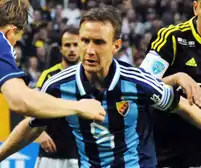
In the middle of 1999 season, Zoran Lukic and Sören Åkeby took over the team and won the inaugural 2000 Superettan, and finished 2nd as newly promoted in the 2001 Allsvenskan. With a team consisting of Stefan Rehn, Kim Källström, Andreas Johansson, and Andreas Isaksson, Djurgården secured its first title in 36 years in the last round of the 2002 Allsvenskan.[3] Later in the year, Djurgården also won Svenska Cupen by beating AIK, 1–0 on golden goal.[11] The first half of the 2000s was a golden era for the club, with three championships (2002, 2003 and 2005) and three cup wins (2002, 2004 and 2005). This marked the end of the golden era for Djurgården, which ended on sixth place in 2006. The club was one of the main contenders for the league championship in 2007, which ultimately led to a third place. The golden era saw the club play against European clubs Juventus, FC Girondins de Bordeaux, Shamrock Rovers F.C., FK Partizan and FC Utrecht. The most remarkable result being the 2–2 draw away against Juventus at Stadio Delle Alpi.
The difficult years
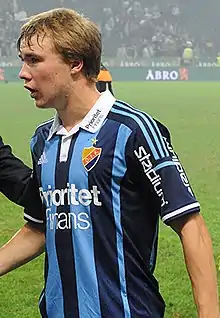
The results went downhill in 2008 and 2009; Djurgården ended up in 14th place in 2009 and had to play through a relegation playoff against Assyriska Föreningen to remain in Allsvenskan. In the early 2010s, Djurgården was a mid-table Allsvenskan team finishing 7th to 11th between 2010 and 2014. When the newly appointed director of sport Bo Andersson who led Djurgården to three titles in the early 21st century came back in 2014 he was forced to sell players such as Daniel Amartey (who became the most expensive defender ever sold by an Allsvenskan club for about 25 million SEK), Erton Fejzullahu, Christian Rubio Sivodedov and Simon Tibbling which stabilized the economy.
The start of something new
In January 2017, Djurgården sold the Kenyan international forward Michael Olunga for a club record fee of 40 million SEK which made the club's financial positions one of the best in the country. The transfer also made it possible to sign club legend Kim Källström and fellow former Swedish international Jonas Olsson. Both players, together with recently returned goalkeeper Andreas Isaksson, played important roles as Djurgården finished in third place in the 2017 Allsvenskan, qualifying for the second qualifying round for the 2018–19 UEFA Europa League for the first time in ten years.
After 13 years without a title Djurgården won the Svenska Cupen on 10 May 2018 going through the Cup scoring 14 goals and not conceding a single goal. They defeated Malmö FF 3–0 in a thrilling final at Tele2 Arena, impressive considering the poor form they had in the league before the game.
Bergstrand and Lagerlöf years (since 2019)
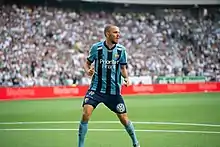
For the 2019 season, Kim Bergstrand and Thomas Lagerlöf became managers of Djurgården.[12] The team won the league title for the first time in fourteen years, securing the title and a spot in the 2020–21 UEFA Champions League third qualifying round on the last day of the season after a 2–2 draw (after being down 2–0 at half time) away from home against IFK Norrköping.[13] After the season Djurgården sold defender and team captain Marcus Danielsson to the Chinese club Dalian Professional for what was reported a club record fee of more than 50 million SEK.[14] This made Djurgården one of Sweden's wealthiest clubs along with various other sales.
The club ended up in fourth place in the 2020 campaign. Highly affected by the COVID-19 pandemic, the start of the season was significantly delayed, and all the games were played with no spectators allowed in the stands.
In 2021 the club ended third in the league, thereby winning a spot in the second qualifying round of the 2022–23 UEFA Europa Conference League. Djurgården also reached the knockout stage of the Svenska Cupen and eventually the semi-finals, where they lost to Malmö FF.
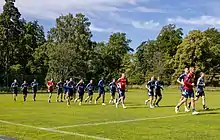
Their 2022–23 UEFA Europa Conference League journey began in the second qualifying round against Rijeka who they defeated 4–1 on aggregate over the two games. With this they advanced to the third qualifying round where they were drawn against the Romanian Cup winners Sepsi OSK, who they managed to beat 6–2 over the two legs. Finally, they were then drawn against the experienced Cypriot campaigners APOEL in the play-off round. The two-legged fixture ended 5–3 in favour of Djurgården, and with this they qualified for the group stages of a European tournament for the first time in club history. They were subsequently drawn into group F alongside Belgian Cup winners Gent, Irish champions Shamrock Rovers and Norwegian neighbours Molde, with whom they had a Nordic derby.
Djurgården secured at least 30 million SEK for qualifying for the group stages.[15] The club advanced to the 2022–23 UEFA Europa Conference League knockout phase after their 4–2 win over Gent in Stockholm, securing another 2 million Euros in prize money. The Swedes topped their group with one game to spare after they came from 2–0 down away against Molde to record a 3–2 win, with Haris Radetinac scoring the winner. They ended up on 16 points, 8 clear of Gent on second place and 9 of Molde in third. They got drawn against the polish club Lech Poznan in the round of 16.
Their domestic 2022 season saw Djurgården securing a European qualifying spot in the 2023–24 UEFA Europa Conference League, in the third to last game of the Allsvenskan season, after other results went in their favour, they ended in second place.
The 2023 campaign ended with massive disappointment both domestic and on the international stage. The swedes were eliminated in the conference league against Luzern from Switzerland in the second qualifying round. The team didn’t do much better in Allsvenskan, they ended 4th after being massive favourites to win after the success the previous season. They managed to qualify for the group stage in the domestic cup after beating Sandviken away from home, and they got drawn in to a group consisting of IFK Göteborg, Nordic United and Skövde AIK.
European cups and tournaments
Notes for the abbreviations in the table below:
- 1R: First round
- 2R: Second round
- QF: Quarter-finals
- PR: Preliminary round
- QR: Qualifying round
- 1QR: First qualifying round
- 2QR: Second qualifying round
- 3QR: Third qualifying round
- PO: Play-off round
- R16: Round of 16
This is Djurgårdens' history in international cups and tournaments, past and forthcoming organised by UEFA. As of March 2023, the club is ranked 92nd by UEFA in its of European football clubs by coefficient, surpassing arch-rivals AIK in the process, and thereby becoming Sweden's second highest ranked team after Malmö FF.
The Royal League is not included since it was not arranged by UEFA and was a tournament for Scandinavian teams only, but the club qualified for the tournament three out of the five years (namely during the seasons 2004–05, 2005–06, and 2007–08).
Supporters and rivalries


Djurgården is one of the most supported clubs in Sweden (with around 24,500 paying members and 14,754 season ticket holders as of 2023), with most of its supporters living in Stockholm and the neighbouring suburbs.[16] Traditionally, the borough of Östermalm is considered to be the club's stronghold (where Stockholms Stadion is located) which is why the stereotypical view of the clubs supporters is, for them to be upper-class since Östermalm is considered one the wealthier parts of the city. However, a 2015 T-shirt campaign suggests that supporters are spread fairly evenly throughout all geographical and socio-economical areas of Stockholm.[17]
Although Djurgården's supporters have been organizing themselves since the late 1940s, with the founding of DIF Supporters Club back in 1947, the 1970s saw singing supporter sections emerging which led to a new supporter club to be founded in 1981, named Blue Saints.[18][19] The supporter club later changed its name in 1997 to Järnkaminerna (lit. the Iron Furnaces) since the old name was perceived to be associated with violence. Järnkaminerna is Djurgården's official supporters' group with a membership of about 5800.[20]
The 2000s saw the emergence and creation of independent ultras groups. The oldest active ultra group, Ultra Caos Stockholm, formed in 2003 is largely influenced by southern European supporter culture.[21]
In 2005 Fabriken Stockholm was formed and took over the role of creating tifos for the team's games from a former, now dissolved group, Ultras Stockholm, founded in the late 1990s. In 2013 a larger and more open organization (Sofia Tifo) was formed and took charge of the terrace choreography, headed by Ultra Caos Stockholm.
The club's ultras are located in the lower part of Sofialäktaren (the Sofia stand), located in the south part of the stadium. The name comes from a hospital, Sophiahemmet, situated behind the northern section of Stockholms stadion where the ultras used to stand when Djurgården played there.
Djurgården supporters
- Fredrik Reinfeldt, former Prime Minister of Sweden
- Joakim Thåström,[22] musician
- Stefan Persson, former CEO, chairman of the board and major shareholder of H&M[23]
- Christer Fuglesang,[24] astronaut, first Scandinavian in space
- Olof Palme,[25] former Prime Minister of Sweden
- Lars Ohly,[26] former leader of Vänsterpartiet
Rivalries
Djurgården's arch-rival is AIK. AIK was founded on 15 February 1891, and Djurgården four weeks later on 12 March, both in Stockholm City Centre. Because of this, games between the teams are called Tvillingderbyt (Derby of the twins) by the media, a name that has not caught on among supporters since they don't view themselves as such. They are also historically the biggest and most successful clubs from Stockholm, with 21 titles won by AIK and 17 by Djurgården. Games between the two teams draw large crowds of rival supporters and can often be highly charged occasions.
Hammarby is the other main rival mostly because of their geographical proximity in central Stockholm, with Djurgården's stronghold in the Östermalm district and Hammarby's in Södermalm. Since 2013, the two teams have shared the same home ground, the Tele2 Arena.
Malmö FF and IFK Göteborg must be viewed the biggest rivals outside of the Stockholm area. The fixtures against these draw almost as much crowd as the derbys, especially the last couple of years. Another rivalry that has come to grow bigger and more intense is with Helsingborg IF, and that after an incident where a Djurgården supporter was beaten to death before the premier of the 2014 season in Helsingborg.
Affiliated schools
These are the schools where lot of the club's junior and academy players go.
- Engelbrektsskolan in Östermalm (grade 4–9)
- Sjölins Gymnasium in Södermalm (high school)
- Stockholms Idrottsgymnasium in Östermalm (high school)
- Gustavsbergs Gymnasium (high school) since 2021/2022
Djurgården have gym/PE teachers working in around 31 different schools around Stockholm as a part of a big project they have together with Djurgårdens hockey section. The goal is to get the city's children to be physically active since children today tend to be less active. The classes Djurgården's teachers have are in addition to the original classes.
Kit
The home shirt has vertical sky and dark blue stripes, hence the club's nickname Blåränderna (the Blue Stripes). The shorts are usually dark blue but have occasionally been white.
Kit manufacturers and sponsors
The club's kit manufacturer, Adidas, presents a new kit every other (even) year. Apart from Adidas, Djurgården has the logos of the following companies visible on their shirt and shorts: Prioritet Finans, a financial-services company; Stadium, a sporting-goods retail chain; Fxoro a financial and trading company; German automakers Volkswagen; Nordic wellness a gym brand and league sponsors Unibet
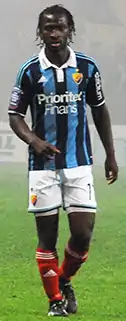
| Period | Kit manufacturer | Shirt sponsor (chest) |
|---|---|---|
| 1976–1979 | Adidas | None |
| 1980 | MasterCharge | |
| 1981 | Köpkort | |
| 1982 | None | |
| 1983 | Atari | |
| 1984–1987 | Året Runt | |
| 1988[27] | Nike | QC Business Card |
| 1989 | Mita Copiers | |
| 1990–1992 | Adidas | |
| 1993 | ICA Kundkort | |
| 1994–1996 | Graphium | |
| 1997 | "Nej till våld och droger!" | |
| 1998 | HP | |
| 1999 | Bewator | |
| 2000–2004 | Kaffeknappen (ICA in European tournaments 2002–2004) | |
| 2005–2012 | ICA | |
| 2013 | Djurgårdsandan | |
| 2014– | Prioritet Finans |
Crest, colours and name
The first crest of the club was a four-pointed silver star in saltire, which had a shield on it with the letters DIF. This star pre-dates the similar star which Idrottsföreningen Kamraterna adopted and is using to this day. The present crest, in the form of a shield in yellow, red, and blue with the text D.I.F. was adopted in 1896. According to an often-quoted poem by Johan af Klercker from 1908, blue and yellow stand for Sweden and red stands for love. Blue and yellow are also the colours of Stockholm and yellow, red and blue are the colors of the crest of Stockholm County.[28]
The club is named after the city park and borough Djurgården, which originally was a royal hunting park. A direct translation of Djurgården would be "animal garden" or "animal yard". The word djur is cognate with the English word "deer", so "deer garden" may have been the name's original meaning. The IF in Djurgårdens IF stands for sports association, and FF in Djurgårdens IF FF stands for football association.
Djurgården has two nicknames: Järnkaminerna (The Iron Stoves) and Blåränderna (The Blue Stripes).
Stadiums
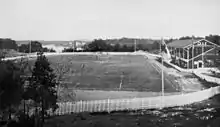
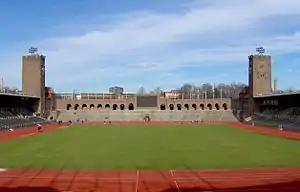
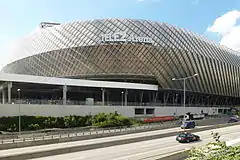
Djurgården's primary stadium since 2013 is Tele2 Arena. The club's first match at Tele2 was a 1–2 defeat to IFK Norrköping on 31 July 2013, which drew 27,798 people. The current record attendance at Tele2 Arena is 28,258 versus Örebro SK on the last home game of the 2019 season.
Between 1936 and 2013, Djurgården's home ground was Stockholm Olympic Stadium, where the national league and cup games were played. Their secondary venue was Råsunda Stadium, where Stockholm derbies against AIK and Hammarby IF were played. The old Olympic Stadium, built in 1912, didn't fulfil UEFA's stadium requirements and therefore international cup games were also played at Råsunda. The club's record attendance at the Olympic Stadium is at least 21,995 against AIK on 16 August 1946.[29][upper-alpha 2] Djurgården's record attendance at Råsunda is 50,750 against IFK Göteborg on 11 October 1959.[31]
The club's first stadium was Stockholms idrottspark where the club played from 1899 until 1906, when it moved to the newly built Östermalm Athletic Grounds.[32] However, in August 1910 Djurgården signed a 25-year contract with the Stockholm City Council to build a stadium in Traneberg, a district west of the inner city.[33] Tranebergs Idrottsplats was finished in October 1911 and inaugurated by Crown Prince Gustaf Adolf.[33] The contract expired in 1935, and with the City Council intending to establish residential housing on the site, Djurgården moved to the Stockholm Olympic Stadium in 1936, where the club had played previously on several occasions after the construction of the stadium in 1912.[34]
As attendances increased in the latter half of the 1940s, the club decided to play some games at the newer and larger Råsunda Stadium.[35][36] And as Djurgården climbed in the league table at the beginning of the 1950s, all games were played at Råsunda.[36] But by the end of the 1960s, Djurgården returned to the Olympic stadium, and soon all games were played there, with the exception of derbies.[36]
The club's achievements in the early 2000s drew larger attendances which led Djurgården to plan for a new stadium with modern facilities and individual seats. Along with political promises in 2006, Djurgården aimed for a rehaul of Stockholm Olympic Stadium and later an entirely new stadium at Östermalms IP.[37][38][39] These plans were abandoned in December 2011 as the building costs exceeded the club's financial capabilities.[40] New stadium requirements from the Swedish Football Association also did not allow Djurgården to play at the Olympic Stadium after 2013.[41] Thus, the club board made the decision to move to Tele2 Arena for the 2013 season.[42]
Youth academy
The youth academy is located at Hjorthagens IP. In December 2012, an indoor arena named "Johan Björkmans hall" with one regulation-size turf and two smaller turfs was built at Hjorthagens IP which enables football training all year around.[43] In 2007 Djurgården invested 65 million SEK (roughly 7 million Euro) in their youth academy, which former director of sports, Göran Aral, described as a unique investment by a Swedish club.[44] In 2015 the training ground for the first team was renovated which enabled the PA19 and PA17 teams to be training at Kaknäs IP and therefore come closer to the first team. The academy has produced players like Simon Tibbling, Emil Bergström, Christian Rubio Sivodedov and Samuel Leach Holm. They recently changed the name of the academy teams from U to PA/FA, meaning boys academy and girls academy. The most recent graduates from the own academy, who made it to the first team is Oscar Pettersson in 2019, Isak Alemayehu in 2022, Max croon, Kalipha Jawla and Gideon Granström all in the winter of 2023.
Players
First-team squad
- As of 7 January 2024[45]
Note: Flags indicate national team as defined under FIFA eligibility rules. Players may hold more than one non-FIFA nationality.
|
|
Out on loan
Note: Flags indicate national team as defined under FIFA eligibility rules. Players may hold more than one non-FIFA nationality.
|
|
Captains
The following players have had the honour of being Captain of the club. (Since 1999)
 Stefan Alfvén (1999-2000)
Stefan Alfvén (1999-2000) Magnus Phersson
Magnus Phersson
(2000-2002)
 Markus karlsson
Markus karlsson
(2002-2005)
 Markus Johanesson
Markus Johanesson
(2005-2009)
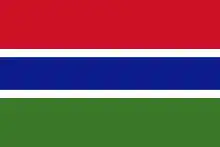 Pa Dembo Touray
Pa Dembo Touray
(2010-2011)
 Joel Riddez
Joel Riddez
(2011-2012)
 Joona Toivio
Joona Toivio
(2012-2013)
 Erton Fejzullahu
Erton Fejzullahu
(2013-2014)
 Emil Bergström
Emil Bergström
(2014-2016)
 Kevin Walker
Kevin Walker
(2016-2017)
 Kim Källström
Kim Källström
(2017-2018)
 Jonas Olsson
Jonas Olsson
(2018-2019)
 Marcus Danielson
Marcus Danielson
(2019-2020)
 Jesper Karlström
Jesper Karlström
(2020-2021)
 Magnus Eriksson
Magnus Eriksson
(2021-present)
Notable players
List criteria:
- player has been named Allsvenskan Top Goalscorer of the year,[46] or
- player has won Guldbollen,[47] or
- player is one of the 12 players named as "DIF-heroes" on the official club website.[48] or
- player has gained 100 caps or more for his country.
Management and boardroom
Management
A list of the staff working with and around the first team squad. As of 12 January 2024[45]
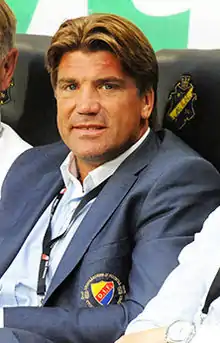
|
Boardroom
As of 2023[49]
Djurgården are to 100% owned by the members of the club, meaning they have the power to choose the boardroom and vote in important questions, they run the club with democracy.
|
Managerial history
It is not known for sure who was the team's manager until 1922, though it is believed that Birger Möller was in charge during a part of the club's first decades.[50]
Honours
League
Cups
- Svenska Cupen:
- Svenska Mästerskapet:
- Allsvenskan play-offs:
- Runners-up (1): 1988
- Corinthian Bowl:
- Rosenska Pokalen:
- Runners-up (1): 1902
- Wicanderska Välgörenhetsskölden:
- Nordic Cup:
Records
- Victory, Allsvenskan: 9–1 vs. Hammarby IF (13 August 1990)
- Loss, Allsvenskan: 1–11 vs. IFK Norrköping (14 October 1945)
- Highest attendance, Råsunda Stadium: 50,750 vs. IFK Göteborg (11 October 1959)
- Highest attendance, Stockholms Stadion: 21,995 vs. AIK (16 August 1946)
- Highest attendance, Tele2 Arena: 28,258 vs. Örebro SK (28 October 2019)[54]
- Most appearances, Allsvenskan: 312, Sven Lindman (1965–80)
- Most goals scored, Allsvenskan: 70, Gösta 'Knivsta' Sandberg (1951–66)
- Record transfer fee paid – 14 million Swedish krona, Thiago Quirino from Atlético Mineiro (winter of 2006)
- Record transfer fee received – 50 million Swedish krona, Marcus Danielson to Dalian Professional (winter of 2020)
Most appearances
Competitive matches only, includes appearances as substitute. Numbers in brackets indicate goals scored.
| # | Name | Years | League | Cup | Europe | Other | Total |
|---|---|---|---|---|---|---|---|
| 1 | 1951–1966 | 322 (77) | 0 (0) | 6 (1) | 0 (1) | 328 (79) | |
| 2 | 1965–1968 1969–1980 |
312 (49) | 2 (0) | 12 (0) | 0 (0) | 326 (49) | |
| 3 | 1968–1984 | 289 (54) | 0 (0) | 8 (0) | 2 (1) | 299 (55) | |
| 4 | 2013–present | 224 (22) | 34 (9) | 21 (1) | 0 (0) | 279 (32) | |
| 5 | 1971–1982 1993 |
265 (0) | 0 (0) | 9 (0) | 2 (0) | 276 (0) | |
| 6 | 1952–1965 | 263 (0) | 0 (0) | 6 (0) | 0 (0) | 269 (0) | |
| 7 | 2003–2012 | 205 (27) | 20 (11) | 10 (0) | 10 (1) | 245 (39) | |
| 8 | 1977–1988 | 236 (17) | 0 (0) | 0 (0) | 6 (1) | 242 (18) | |
| 9 | 2000–2011 | 195 (1) | 16 (0) | 14 (0) | 12 (0) | 237 (1) | |
| 10 | 2000–2005 2013–2014 |
172 (50) | 30 (16) | 14 (4) | 3 (0) | 219 (70) |
Footnotes
- ↑ In the media, "Djurgårdens IF" is normally abbreviated "Dif", in accordance with Swedish writing standards that state that acronyms that are pronounced as a word, as opposed to letter by letter, should be spelled with the first letter in upper case and the remaining in lower case, thus "Dif". However, some fans of the club, as well as the club itself, prefer to use only uppercase, "DIF", even though they also pronounce it as a word: [diːf].
- ↑ Djurgården's record at Stockholm Olympic Stadium is disputed. Gänger, 2006, suggest the attendance was 21,995 while Rehnberg, 1991, suggest it was 22,108.[30]
- ↑ Ball was fired before Allsvenskan started.
- ↑ The title of "Swedish Champions" has been awarded to the winner of four different competitions over the years. Between 1896 and 1925 the title was awarded to the winner of Svenska Mästerskapet, a stand-alone cup tournament. No club were given the title between 1926 and 1930 even though the first-tier league Allsvenskan was played. In 1931 the title was reinstated and awarded to the winner of Allsvenskan. Between 1982 and 1990 a play-off in cup format was held at the end of the league season to decide the champions. After the play-off format in 1991 and 1992 the title was decided by the winner of Mästerskapsserien, an additional league after the end of Allsvenskan. Since the 1993 season the title has once again been awarded to the winner of Allsvenskan.[52]
References
- Gänger, Hasse (2007). Djurgårdens IF Fotboll 1899–2006 (in Swedish). Stockholm: Djurgårdens IF Fotboll. ISBN 978-91-633-0992-2.
- Hagström, Magnus; Johansson, Peter; Jurell, Carl (2010). Vad för jävla pack e ni? (in Swedish). Imperial Publishing. ISBN 978-91-978734-0-6.
- Rehnberg, Bo; Wickman, Mats, eds. (1991). Djurgårdens IF 100 år: 1891–1991 (in Swedish). Sellin & Partner förlag. ISBN 91-7055-029-8.
- ↑ "Kontaktuppgifter och tävlingar – Stockholms Fotbollförbund – Svenskfotboll.se". Archived from the original on 7 December 2011. Retrieved 13 January 2011.
- 1 2 Andersson, Torbjörn (2002). Kung fotboll: den svenska fotbollens kulturhistoria från 1800-talets slut till 1950..
- 1 2 3 4 5 6 7 8 Cederquist, Jonas (2010). Stockholms fotbollshistoria 1880–2010 [History of Football in Stockholm 1880–2010] (in Swedish). Stockholmia förlag. ISBN 978-91-7031-222-9.
- 1 2 3 "Svenska mästare 1896-25, 1931- - Svensk fotboll". Archived from the original on 12 December 2022. Retrieved 19 March 2023.
- ↑ "Norge - Sverige - Matchfakta - Svensk fotboll". Archived from the original on 18 March 2023. Retrieved 18 March 2023.
- ↑ "Archived copy" (PDF). Archived from the original (PDF) on 30 June 2019. Retrieved 18 March 2023.
{{cite web}}: CS1 maint: archived copy as title (link) - ↑ Lindgren, Axel (1939). "Djurgårdens Idrottsförening". Nordisk familjeboks sportlexikon: uppslagsverk för sport, gymnastik och friluftsliv. Band 2 Bröstsim–Flugfiske (in Swedish). Stockholm: Nordisk familjeboks förlag. pp. 686–691.
- ↑ "Svenska Cupen genom åren - Svensk fotboll".
- ↑ Årets football 1988 [1988 Football of the year].
- ↑ Gänger, 2007. sid. 40
- ↑ "Djurgården tog ett nytt guld - då kändes det som man var i England". aftonbladet. 10 November 2002.
- ↑ "Klart: De tar över Djurgården efter Özcan". Aftonbladet. 16 November 2018.
- ↑ "Djurgården är svenska mästare 2019 – efter supervändningen". Aftonbladet. 2 November 2019.
- ↑ "Avslöjar: Djurgården gör rekordaffär på Marcus Danielson". Expressen (in Swedish). Archived from the original on 28 February 2020. Retrieved 28 February 2020.
- ↑ "Klart: Så många miljoner spelade Djurgården in i Europa".
- ↑ "AIK, DIF och Hammarby – hur ser supportrarna ut egentligen?". MEC Sverige. Archived from the original on 31 August 2013.
- ↑ "Leaderbord T-shirts DIF Stockholm". Google Docs.
- ↑ Hagström p. 55
- ↑ Hagström p. 67
- ↑ "Över 5500 medlemmar – och rekord igen!". Järnkaminerna (in Swedish). Archived from the original on 30 March 2009. Retrieved 20 April 2021.
- ↑ "Om oss" (in Swedish). Ultra Caos Stockholm. Archived from the original on 17 November 2010. Retrieved 17 December 2011.
- ↑ "Thåström håller på Dif". Expressen. Archived from the original on 16 September 2017. Retrieved 11 April 2017.
- ↑ "H&M-miljardären öppnar för att satsa i Djurgården" (in Swedish). Fotbollskanalen. 8 May 2015. Archived from the original on 10 May 2015. Retrieved 8 May 2015.
- ↑ "Djurgården får stöd – från rymden". Aftonbladet (in Swedish). 28 May 2009. Archived from the original on 22 April 2014. Retrieved 21 April 2014.
- ↑ Laul, Robert (15 April 2020). "Nakna sanningen om Torbjörn Nilsson och Olof Palme". Aftonbladet. Archived from the original on 2 March 2022. Retrieved 2 March 2022.
- ↑ Bergström, Kristoffer (8 October 2007). "Utbrottet". Aftonbladet. Archived from the original on 2 March 2022. Retrieved 2 March 2022.
- ↑ "Lagbilder – DIF Historia" (in Swedish). Archived from the original on 26 August 2022. Retrieved 26 August 2022.
- ↑ "Det första klubbmärket". DIFarkivet.se (in Swedish). Archived from the original on 2 December 2021. Retrieved 5 April 2021.
- ↑ Gänger, p. 216.
- ↑ Rehnberg, p. 444.
- ↑ "Djurgårdsguld inför rekordpublik". Dagens Nyheter (in Swedish). Stockholm. 12 October 1959. p. 1.
- ↑ Rehnberg, p. 288.
- 1 2 Rehnberg, pp. 43–44.
- ↑ Rehnberg, p. 67.
- ↑ Gänger, pp. 215–219.
- 1 2 3 "DIF:s hemmaarenor i Allsvenskan" (in Swedish). Djurgårdens IF Fotboll. Archived from the original on 13 August 2010. Retrieved 22 December 2011.
- ↑ "Arenafrågan – detta har hänt". Dagens Nyheter (in Swedish). 22 April 2009. Retrieved 6 January 2012.
- ↑ Riedel, Jonas. "Förslag till ny arena" (in Swedish). Djurgårdens IF Fotboll. Archived from the original on 19 February 2015. Retrieved 6 January 2012.
- ↑ Bengtsson, Janne (14 July 2010). "Djurgården närmare en ny arena". Svenska Dagbladet (in Swedish). Archived from the original on 12 September 2014. Retrieved 6 January 2012.
- ↑ Ask, Erik (6 December 2011). "Djurgården lägger ner arenaplanerna". Dagens Nyheter (in Swedish). Archived from the original on 7 January 2012. Retrieved 6 January 2012.
- ↑ "Rekommendationen: Stockholmsarenan 2013" (in Swedish). Djurgårdens IF Fotboll. Archived from the original on 19 January 2012. Retrieved 6 January 2012.
- ↑ Arnesen, Jonas (5 October 2011). "Stockholms-arenan blir Dif:s nya hem". Svenska Dagbladet (in Swedish). Archived from the original on 11 October 2011. Retrieved 6 January 2012.
- ↑ "Djurgårdens nya superhall invigd". Fotbolldirekt (in Swedish). 2 December 2012. Archived from the original on 16 January 2017. Retrieved 15 August 2016.
- ↑ "Djurgården satsar 65 miljoner på unga". SVT (in Swedish). 22 November 2007. Archived from the original on 16 August 2016. Retrieved 15 August 2016.
- 1 2 "Truppen" (in Swedish). Djurgårdens IF. Archived from the original on 10 January 2019. Retrieved 26 January 2016.
- ↑ "Allsvenska skyttekungar & publiksnitt 1925–". svenskfotboll.se (in Swedish). Archived from the original on 9 June 2009. Retrieved 12 December 2011.
- ↑ "Guldbollen". svenskfotboll.se (in Swedish). Archived from the original on 3 April 2012. Retrieved 12 December 2011.
- ↑ "DIF-hjältar" (in Swedish). Djurgårdens IF Fotboll. Archived from the original on 25 August 2010. Retrieved 12 December 2011.
- ↑ "Styrelse" (in Swedish). Djurgårdens IF. Archived from the original on 6 August 2017. Retrieved 7 April 2017.
- 1 2 3 4 5 Gänger, pp. 68–69
- 1 2 3 "Historia" (in Swedish). Djurgårdens IF Fotboll. Archived from the original on 1 February 2012. Retrieved 12 December 2011.
- ↑ "Svenska mästare 1896–1925, 1931–". svenskfotboll.se (in Swedish). Archived from the original on 2 December 2009. Retrieved 25 November 2009.
- ↑ "Finsk seger på straff mot Djurgården i cupen", Svenska Dagbladet, Stockholm, p. 13, 1 August 1962, archived from the original on 26 February 2018, retrieved 26 February 2018
- ↑ "Fotboll: Djurgården har skaffat sig guldläge – en poäng räcker i Norrköping". SVT. 28 October 2019. Archived from the original on 29 October 2019. Retrieved 29 October 2019.
External links
- Official websites
- Djurgården Fotboll – official site
- Djurgården Fotboll – at the UEFA official site
- Djurgården Fotboll – at the Allsvenskan official site (archived 28 December 2012)
- Supporter websites
- Järnkaminerna Stockholm – official supporter club site
- Djurgårdens Supporters Club – supporter site
